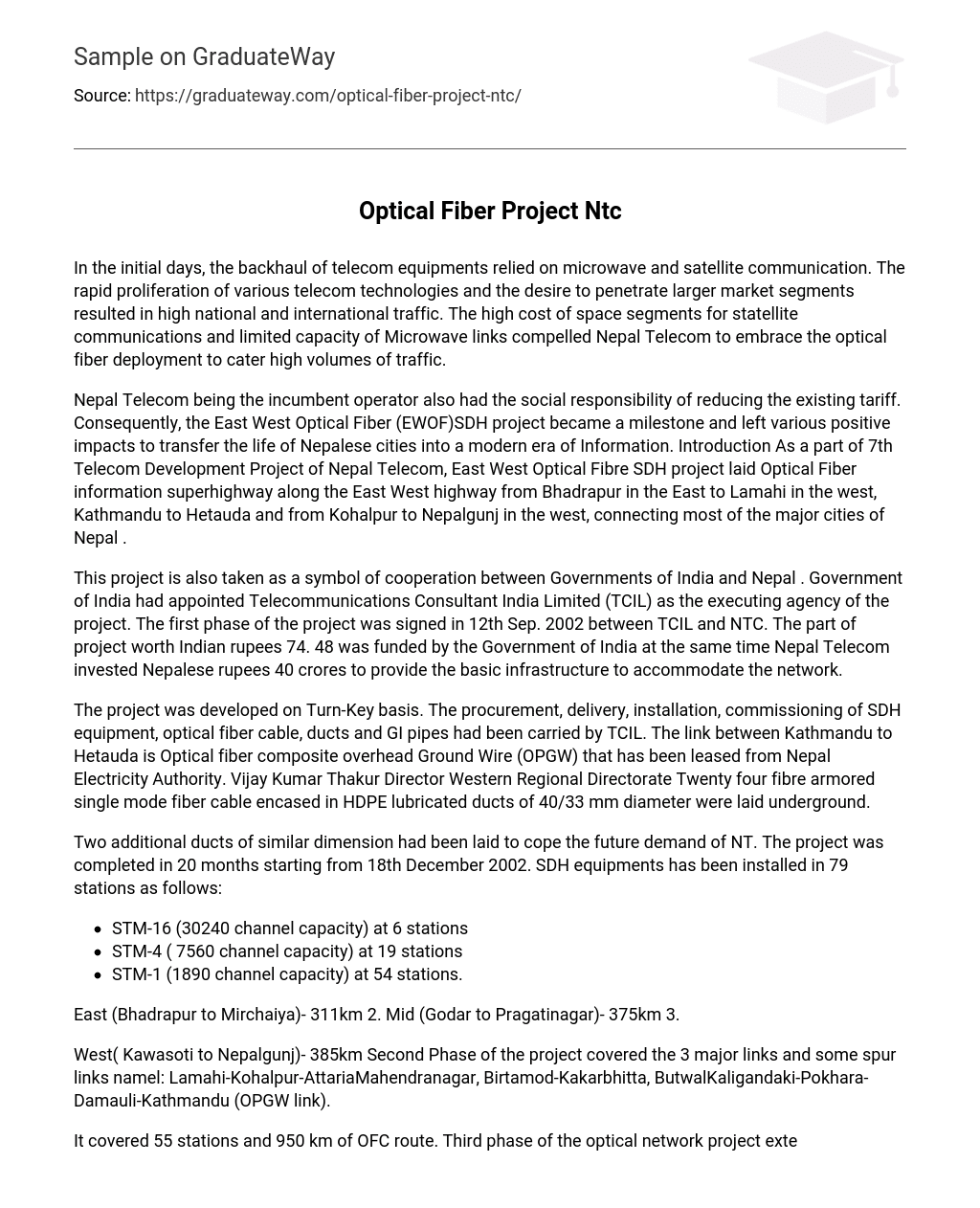Initially, the backhaul of telecom equipment depended on microwave and satellite communication. However, as different telecom technologies rapidly expanded and the need to reach larger market segments increased, there was a significant growth in national and international traffic. Due to the expensive space segments for satellite communications and the limited capacity of microwave links, Nepal Telecom decided to adopt optical fiber deployment in order to handle large volumes of traffic.
Nepal Telecom, as the incumbent operator, had the social responsibility of reducing existing tariffs. The East West Optical Fiber (EWOF) SDH project was a milestone that had various positive impacts on the transformation of Nepalese cities into the modern era of Information. As a part of the 7th Telecom Development Project of Nepal Telecom, the East West Optical Fibre SDH project laid an Optical Fiber information superhighway along the East West highway. It covered the stretch from Bhadrapur in the East to Lamahi in the west, connecting Kathmandu to Hetauda and Kohalpur to Nepalgunj in the west. This network connected most of the major cities of Nepal.
This project is a symbol of cooperation between the Governments of India and Nepal. The Government of India appointed Telecommunications Consultant India Limited (TCIL) as the executing agency. The first phase of the project was signed on September 12, 2002, between TCIL and NTC. The Government of India funded the project with Indian rupees 74.48, while Nepal Telecom invested Nepalese rupees 40 crores to establish the basic infrastructure for the network.
The project was implemented on a Turn-Key basis, with TCIL responsible for the procurement, delivery, installation, and commissioning of SDH equipment, optical fiber cable, ducts, and GI pipes. The link from Kathmandu to Hetauda consists of Optical fiber composite overhead Ground Wire (OPGW), which was leased from Nepal Electricity Authority. Vijay Kumar Thakur, Director of Western Regional Directorate, oversaw the laying of twenty-four armored single mode fiber cables encased in HDPE lubricated ducts with a diameter of 40/33 mm.
In order to meet the future demand of NT, two more ducts of similar dimension were constructed. The entire project, which began on 18th December 2002, was completed in a span of 20 months. SDH equipment was installed in a total of 79 stations.
- STM-16 (30240 channel capacity) at 6 stations
- STM-4 ( 7560 channel capacity) at 19 stations
- STM-1 (1890 channel capacity) at 54 stations.
The distance from Bhadrapur to Mirchaiya is 311km, while the distance from Godar to Pragatinagar is 375km.
The second phase of the project, which covers a distance of 385km from Kawasoti to Nepalgunj in the west, includes three major links and some spur links. These major links are Lamahi-Kohalpur-AttariaMahendranagar, Birtamod-Kakarbhitta, and ButwalKaligandaki-Pokhara-Damauli-Kathmandu (OPGW link).
The optical network project’s third phase extends the network to China through Tatopani, along the Araniko highway connecting Bhaktapur, Banepa, and Dhulikhel. It covers 55 stations and 950 km of OFC route. To synchronize the network, a Primary Reference Clock (PRC) is fed at Patan, and 2 GPS-based SSUs are installed at Itahari and Butwal.
The Network Management System (NMS) installed at Patan allows for control of various network elements, including Fault Management, Performance Management, Configuration Management, and Security Management. The installation and commissioning of optical fiber network has greatly improved the bandwidth and brought the country into the modern era of information and communication technology. This project has transformed the lives of the people, empowering them to establish both small and large enterprises in the field of information and communication technology.
The emergence of the Next Generation Network technology has created new job opportunities within the country, including cyber cafes, mobile shops, and repair and maintenance centers. In response to community demand, NT has established exchanges utilizing this technology. Additionally, a greater number of BTS’s are now connected through high bandwidth optical fiber, replacing the previous use of radios. This upgrade resulted in numerous benefits, such as an increased number of voice and data channels, as well as trunk capacity. Consequently, NT was able to significantly reduce domestic trunk call tariffs from Rs. 9 to Re. 1 immediately after implementing the network, with further reductions for any media. The international trunk call tariff has also been reduced to 1/10th of the initial rate. With the vast bandwidth offered by this network, it can be utilized for various purposes.
Some of these include: Connecting GSM and CDMA BTSs to offer 3G/multimedia services, setting up a core IP network towards NGN., IT-enabled service industries such as Business Process Outsourcing, Video conferencing, and E-Learning, Telemedicine, E-commerce, E-governance, Fiber To The Home (FTTH).
Nepal Telecom has already completed the installation of optical fibre links to the exchanges, commonly known as Fibre To The Exchanges (FTTX). As the demand for high bandwidth increases due to modern multimedia applications, some network operators around the world are replacing the existing copper wire with optical fiber from the exchange to the customer premise. This concept is known as Fiber To The Home (FTTH). The existing optical fiber network will allow us to pursue this new opportunity.
Currently, many FTTH networks offer transmission speeds of up to 100 megabits per second downstream and a similar speed upstream. Some providers even provide speeds of up to one gigabit per second. One advantage of fiber optic technology is its potential for future growth, as advancements will allow for significant increases in bandwidth over existing infrastructure.
In summary, the Optical Fiber network has played a vital role in developing our nation’s information and communication technology sector. It has enabled both service-oriented businesses and the public to establish a global presence. Going forward, our focus should be on creating multimedia content that caters to various aspects of our daily lives. This will reduce our reliance on external bandwidth and protect our valuable national income.





